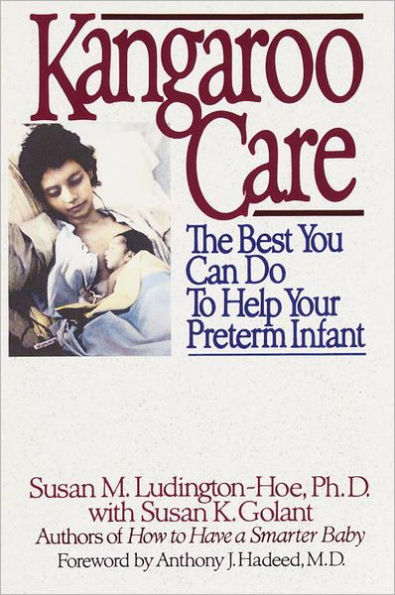Give Your Preterm Baby the Best Possible Start in Life
If you have just given birth to a preterm infant, you and your baby both face special challenges. Parents long to help their baby but often feel isolated frightened by hospital procedures.
Now there is wonderful news for both babies and parents. Kangaroo Care, a technique pioneered in leading neonatal centers worldwide, gives you a unique role: a special way of holding your infant that provides crucial health benefits—including shorter hospital stays.
Based on ground-breaking research, Kangaroo Care is a step-by-step guide to bringing these benefits to your baby—even if your neonatal unit does not yet have a Kangaroo Care program. It explains:
• Why Kangaroo Care enhances your baby’s development
• How to use the technique even if your infant requires a ventilator or an incubator
• How to understand your baby’s signals of distress or comfort—and how to respond
• How you can work with the neonatal staff to provide the best for your baby between your visits
• How to involve fathers as well as mothers
• All the proven results of Kangaroo Care—including a more relaxed, healthier, and contented baby
The complete parents’ guide to the revolutionary new treatment for preterm babies: Kangaroo Care
1111593405
If you have just given birth to a preterm infant, you and your baby both face special challenges. Parents long to help their baby but often feel isolated frightened by hospital procedures.
Now there is wonderful news for both babies and parents. Kangaroo Care, a technique pioneered in leading neonatal centers worldwide, gives you a unique role: a special way of holding your infant that provides crucial health benefits—including shorter hospital stays.
Based on ground-breaking research, Kangaroo Care is a step-by-step guide to bringing these benefits to your baby—even if your neonatal unit does not yet have a Kangaroo Care program. It explains:
• Why Kangaroo Care enhances your baby’s development
• How to use the technique even if your infant requires a ventilator or an incubator
• How to understand your baby’s signals of distress or comfort—and how to respond
• How you can work with the neonatal staff to provide the best for your baby between your visits
• How to involve fathers as well as mothers
• All the proven results of Kangaroo Care—including a more relaxed, healthier, and contented baby
The complete parents’ guide to the revolutionary new treatment for preterm babies: Kangaroo Care
Kangaroo Care: The Best You Can Do to Help Your Preterm Infant
Give Your Preterm Baby the Best Possible Start in Life
If you have just given birth to a preterm infant, you and your baby both face special challenges. Parents long to help their baby but often feel isolated frightened by hospital procedures.
Now there is wonderful news for both babies and parents. Kangaroo Care, a technique pioneered in leading neonatal centers worldwide, gives you a unique role: a special way of holding your infant that provides crucial health benefits—including shorter hospital stays.
Based on ground-breaking research, Kangaroo Care is a step-by-step guide to bringing these benefits to your baby—even if your neonatal unit does not yet have a Kangaroo Care program. It explains:
• Why Kangaroo Care enhances your baby’s development
• How to use the technique even if your infant requires a ventilator or an incubator
• How to understand your baby’s signals of distress or comfort—and how to respond
• How you can work with the neonatal staff to provide the best for your baby between your visits
• How to involve fathers as well as mothers
• All the proven results of Kangaroo Care—including a more relaxed, healthier, and contented baby
The complete parents’ guide to the revolutionary new treatment for preterm babies: Kangaroo Care
If you have just given birth to a preterm infant, you and your baby both face special challenges. Parents long to help their baby but often feel isolated frightened by hospital procedures.
Now there is wonderful news for both babies and parents. Kangaroo Care, a technique pioneered in leading neonatal centers worldwide, gives you a unique role: a special way of holding your infant that provides crucial health benefits—including shorter hospital stays.
Based on ground-breaking research, Kangaroo Care is a step-by-step guide to bringing these benefits to your baby—even if your neonatal unit does not yet have a Kangaroo Care program. It explains:
• Why Kangaroo Care enhances your baby’s development
• How to use the technique even if your infant requires a ventilator or an incubator
• How to understand your baby’s signals of distress or comfort—and how to respond
• How you can work with the neonatal staff to provide the best for your baby between your visits
• How to involve fathers as well as mothers
• All the proven results of Kangaroo Care—including a more relaxed, healthier, and contented baby
The complete parents’ guide to the revolutionary new treatment for preterm babies: Kangaroo Care
6.99
In Stock
5
1

Kangaroo Care: The Best You Can Do to Help Your Preterm Infant
304
Kangaroo Care: The Best You Can Do to Help Your Preterm Infant
304Related collections and offers
6.99
In Stock

Product Details
| ISBN-13: | 9780307813381 |
|---|---|
| Publisher: | Random House Publishing Group |
| Publication date: | 02/01/2012 |
| Sold by: | Random House |
| Format: | eBook |
| Pages: | 304 |
| File size: | 7 MB |
About the Author
From the B&N Reads Blog
